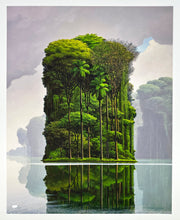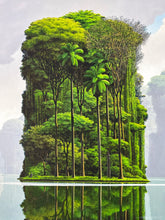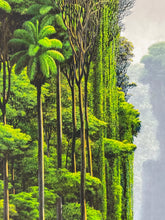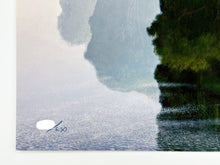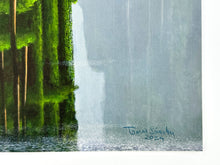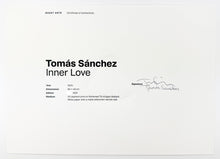
Dimensions: 23.6 x 19 Inches / 60 x 48 cm
Medium: UV pigment print on 410gsm Somerset TS Radiant White paper with a matte silkscreen varnish seal.
Provenance: Hand-signed and numbered by the artist. Comes with original publisher issued certificate of authenticity hand-signed by Tomas Sanchez.
Edition: Limited Edition of 630
Year: 2024
Condition: Excellent
ABOUT THE ART
Internal and external reflections coalesce in a print by Tomás Sánchez.
Cuban artist Tomás Sánchez paints surreal visions of utopia in mind-bending detail. The artworks embody his commitment to preserving what remains of the wilderness, and a personal relationship with meditation spanning five decades.
Inner Love places its cross-legged subject on a mirage-like island, mirrored perfectly in the water that surrounds it. As with many of the artist's landscapes, the scene is inspired by verdant forests and tranquil rivers close to his studio in Costa Rica. For Sánchez, the artwork provides space for a moment of self-reflection.
"I believe that Inner Love is a painting that can transmit to others the same peace that it transmits to me and, today, it is invaluable to receive a bit of peace."
The edition transforms a larger painting into a fine-tuned UV pigment print complete with a silkscreen varnish seal. Printmakers paid particular attention to fidelity and colouration, both of which are integral to Sánchez’ work, throughout the process.
ABOUT THE ARTIST
Sánchez’s symbolic landscapes have made him one of the most important living Cuban artists. Part of Volumen Uno in the 80s, a movement that resisted the heavily censored Cuban art of the time, he has since received international recognition, with auction prices in excess of $600,000 USD. Inspired by the Romantics, Sánchez paints the wilderness of his homeland, as well as vast panoramic views of garbage dumps. The works are incredibly detailed with a lush tropical palette, encompassing the physical wonder of the natural world, it’s immense spiritual power, and humankind's tendency to destroy it. Small human figures set against waterfalls, lagoons and palm trees engage with humankind's insignificance, search for inner peace, and broader environmental issues. Steeped in allegory, Sánchez’s art reinterprets traditional modes of painting to create an uncanny paradise that is at once hopeful and threatening.
While Sánchez is best known for his hyperreal landscapes, he has also experimented in print, sculpture, photography, drawing, and with different styles of painting. His earlier works under the title Expressionism explore a looser painted gesture steeped, as ever, in symbolism. El Circo/The Circus (1974), is an oil on canvas depicting a circus tent with a raucous crowd watching Jesus being carried on the cross. There is a red bullfighting cloth on the stage, but a chicken instead of a bull; the two men pulling the cross and gearing the crowd wear red colonialist hats. Various angels and the Virgin Mary are among the audience members, all of whom watch with both eagerness and dread. The work plays with tropes of religious iconography as a sardonic metaphor for the performativity of religion, colonialism, politics and populism, whether ancient or contemporary.










